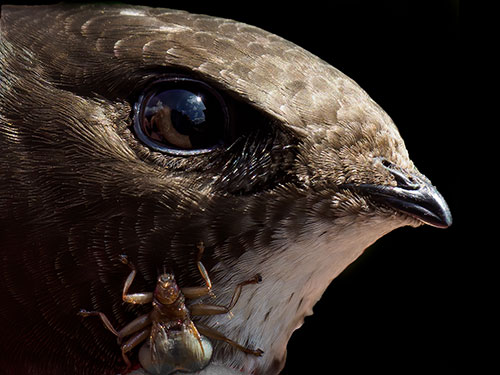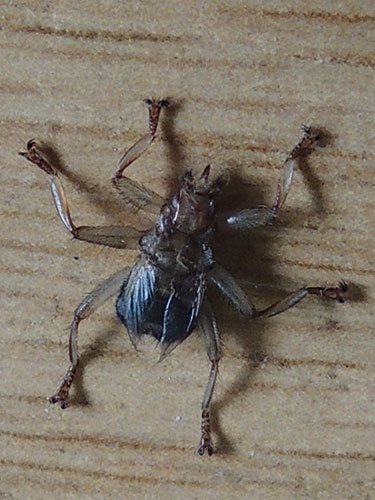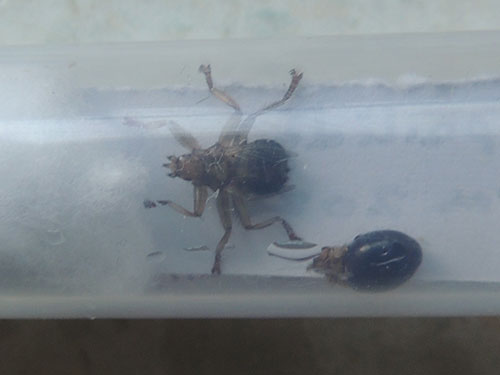


Crataerina pallida on Swift
Photo: © Darren E. Nicholls, 2020

Crataerina pallida
Photo: © Denise Wawman, 2021

Crataerina pallida emerging from puparia
Photo: © Denise Wawman, 2021
Crataerina pallida is one of a group of blood-sucking parasitic flies found on found on birds in the UK. Together with keds, flat flies (also known as louse flies) belong to the family of Diptera called the Hippoboscidae.
They are perfectly adapted to the role of parasites. They can move sideways like a crab to escape birds and have feet specially adapted to cling on. Their flattened body shape allows them to hide in feathers and to move close to the skin making it more difficult for a bird to remove them while preening. In the species which can fly, fast, silent flight allows them to approach a host undetected.
Flat flies can only survive for a few days away from their hosts and most feed daily, so they are rarely seen away from their hosts. Most bird ringers and people working in wildlife rehabilitation will be familiar with this group of flies, as they will often leave their hosts when these are handled. They are sometimes seen on walls under birds’ nests but are otherwise rarely encountered. Do they bite humans? No, although they have been forced to under extreme experimental conditions.
Flat flies have an unusual life cycle. The female fly doesn’t lay her eggs but raises one larva at a time inside her uterus, feeding it a secretion from a “milk gland”. When it is mature, she releases it and it immediately starts to pupate, falling off the bird, to metamorphose, emerge and find a new host.
Most Crataerina pallida are found on Swift nestlings, an ideal strategy any puparia will be deposited into the Swift’s nest and will be waiting, ready for the adult fly to emerge, when the Swifts return to their nest sites the following year.
In most cases they do not harm to their hosts, and even in heavily infested broods, the adult Swifts can compensate by increasing the amount that they feed their chicks if weather conditions are good.
Compared to other species of flies, flat flies are a long-lived species. Flat flies can live for three to six months. Death usually occurs either with the death of their host or because the host eats them. Those which narrowly escape often have damaged wings.
You are very unlikely to see this species in the UK at this time of year. Its main host, the Common Swift, has departed to Africa and although it has been recorded occasionally from Swallow, most these have also left the UK, but the shiny, round, black, puparia may be found in old Swift nests.
Other species of flat flies may be encountered in the UK at this time of year. Looking similar to Crataerina pallida, but with longer narrower wings, Stenepteryx hirundinis (also known as Crataerina hirundinis) is a parasite of House Martins and sometimes Swallows and Sand Martins. Flies of the genus Ornithomya may be seen as late in the year as December. The smaller flies in this genus are more complicated to identify, and currently DNA testing is helping to redefine the species, but currently the best guide to the UK species is that by Tony Hutson (Hutson, A. M. (1984) ‘Keds, Flat-flies and Bat-Flies: Diptera, Hippoboscidae and Nycteribiidae’, Handbooks for the Identification of British Insects, 10(7)).
Species records can be entered via iRecord, ideally with clear photographs showing the main ID features of the fly for verification, and a record of the host species in the comments section. In time, a new field for host species will be available if you navigate to iRecord from the recording scheme webpage, https://www.dipterists.org.uk/hippoboscidae-scheme/home. If you have a lot of records to enter, I can upload them from a spreadsheet. I can be contacted, with records or for help with identification, via the link on the recording scheme webpage.
Denise Wawman
Every month it is our aim to highlight a species that is “in-season” and, although not necessarily rare or difficult to identify, has been highlighted by our local recording groups as being somewhat under-recorded and for which new records would therefore be welcomed.
If you or your recording group are aware of species such as this then please contact Bob Foreman.